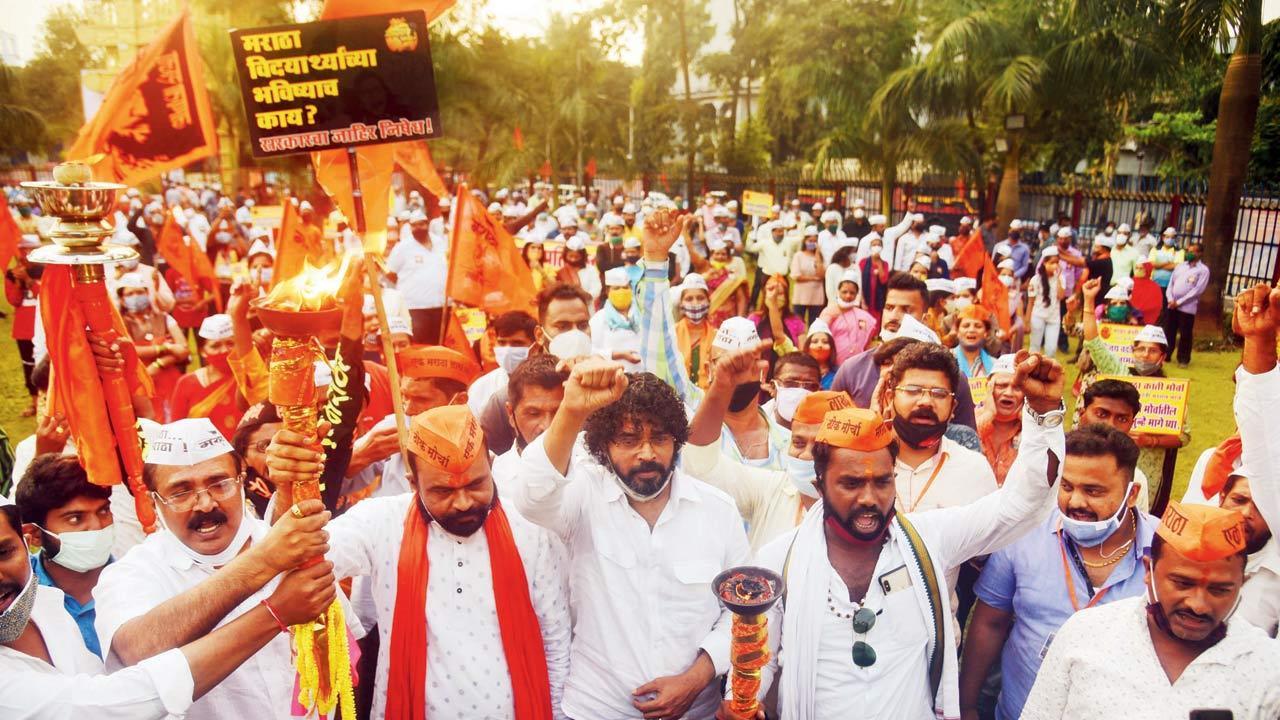The reservation policy seeks to divide the Other Backward Classes, and exploit the tension among them to stitch an electoral majority for the ruling party—and win the war for creating the Hindu Rashtra

It is the OBCs who justifiably have the first right to enjoy the benefits arising from the removal of the cap on reservation. Pic/Atul Kamble
After India emerges from the ravages of the Covid-19 pandemic, battered and mourning the dead, its people will find Prime Minister Narendra Modi has sucked them deeper into two inter-related wars. One of these wars, underway since May 2014, seeks to establish a Hindu nation. The other has the goal of keeping intact the caste hierarchy.
ADVERTISEMENT
The second war was heralded, ironically, with the Supreme Court striking down the quota for the Marathas. The quantum of the Maratha quota had Maharashtra exceed the 50 per cent cap on reservation, which is permissible only in extraordinary circumstances. This test the Maharashtra government flunked.
But the 50 per cent cap was also removed by the 103rd Amendment Act, through which the Modi government allocated a 10 per cent quota to the Economically Weaker Sections belonging to castes outside all reservation categories – the Scheduled Castes, the Scheduled Tribes, and the Other Backward Classes. The Supreme Court will decide whether the 103rd Amendment violates the Constitution’s basic structure.
Regardless of the Supreme Court’s verdict, the EWS quota overturns the philosophy of reservation, which seeks to remove historical disabilities that impede certain castes from competing with others on an equal footing. Their disabilities arise from their low social status, which is linked to their traditional occupations deemed polluting. The caste-occupation linkage prevented certain social groups from acquiring an education, which explains their negligible presence in the middle class today.
It is to create a level playing field to socially diversify the middle class that reservation policies worldwide discriminate in favour of the historically disadvantaged. These policies focus on social groups, not individuals among them. This is because all social groups will have rich and poor among them. But all social groups are not adequately represented in the power structure, with some overrepresented and others barely present or missing.
A Supreme Court validation of the EWS quota would shrink, by 10 per cent, the general category in which all social groups compete, upsetting the fine balance between merit-based competition (50 per cent) and reservation (50 per cent). The EWS quota is confined to the socially advanced group, which comprises castes more than adequately represented in government jobs. In one stroke, reservation has been turned into a tool for promoting individual economic mobility, perceived to benefit the poor Brahmins most, rather than overcoming historical disabilities of castes. This ensures the upper caste hegemony.
The validation of the EWS quota would leave the OBCs with a sense of betrayal, for the Mandal Commission estimated them to be around 52 per cent of India’s population. Yet it recommended a 27 per cent quota for the OBCs so that together with the SC and ST quotas the 50 per cent cap was not transgressed. It would be a cruel irony if the Supreme Court, for whatever constitutional logic, upholds the removal of the cap for accommodating the upper castes in the reservation pool.
It is the OBCs who justifiably have the first right to enjoy the benefits arising from the removal of the cap on reservation. Not only have they been denied this right, the Centre has also refused to make public the socio-economic caste census conducted in 2011. It is commonly believed the caste census data has been suppressed because it likely shows the OBC population to be higher than the earlier estimated 52 per cent – and that could, therefore, become the basis for them to demand an increase in their quota.
The tinkering with the OBC reservation does not end there. For instance, the Supreme Court has upheld the 102nd Amendment Act, which entitles only the President, acting on the advice of the Union government, to publish the “first list” of castes entitled to OBC reservations in the States and Union Territories. This will have the Modi government to play favourites among OBC castes for their votes.
From the first list of reservation, castes can be taken out, according to the Supreme Court’s majority opinion on the 102nd Amendment, only by Parliament. The Modi government, theoretically, can use its majority in the Lok Sabha and team up with its allies in the Rajya Sabha to exclude, say, Caste Y in Uttar Pradesh from the OBC reservation pool.
Then there is also the Rohini Commission, which is subcategorising the OBCs. This exercise will split the OBCs into likely four groups and divide and distribute the 27 per cent reservation among them. Sub-categorisation is recommended for ensuring dominant groups among the OBCs do not corner the reserved jobs.
But doubts have already been raised over the methodology the Rohini Commission is using to subcategorise the OBCs. It has not found out the population of castes comprising the OBCs. A subcategorisation exercise based on computing the number of jobs each caste has, without taking its population into account, would make it unjust. Assume Caste Y has a population of 10 lakh and possesses 10 reserved jobs, in contrast to Caste X with a count of one lakh having one job. On paper, Caste Y would seem to have scored over Caste X, although their gains are in proportion to their populations. Modi’s reservation policy seeks to divide the OBCs, and exploit the tension among them to stitch an electoral majority for himself – and win the war for creating the Hindu Rashtra.
The writer is a senior journalist. Send your feedback to mailbag@mid-day.com
The views expressed in this column are the individual’s and don’t represent those of the paper.
 Subscribe today by clicking the link and stay updated with the latest news!" Click here!
Subscribe today by clicking the link and stay updated with the latest news!" Click here!







